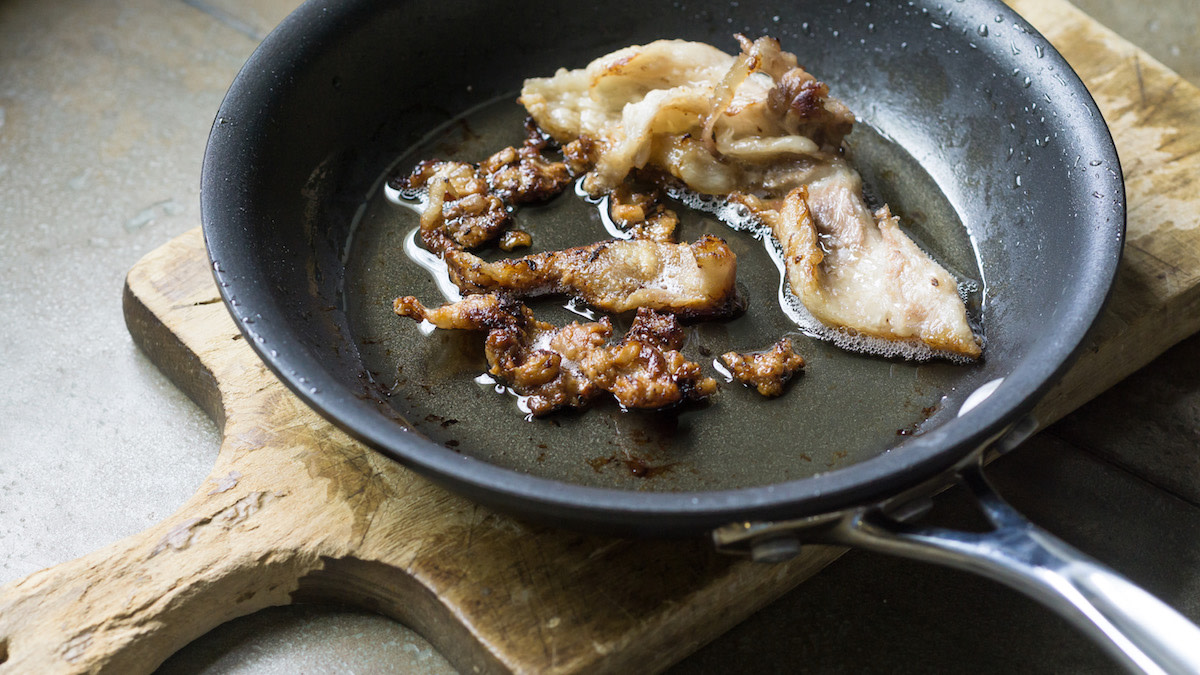
One of my favorite things about acquiring my own wild meat is that it comes with an added bonus: fat. Many hunters overlook wild game fat and dismiss it as they would most stuff from the gut pile. Wild game fat has great value, though.
Duck fat, for example, is treasured by foodies and some folks pay serious money for dishes that include this ingredient. But the value of wild game fat extends beyond birds, and if you’re lucky enough to acquire a fair amount of it, make sure you know how to turn it into liquid gold.
In culinary terms, rendering fat from a deer is referred to as tallow. Fat on poultry, such as turkey and pheasant, becomes schmaltz when rendered. Fat on a hog is called lard after rendering.
Beyond cooking uses, wild game fat can be made into soap, bird suet, and you can even use a jar of bear grease to predict weather patterns.
Since wild game is relatively lean, it can seem like a lot of effort to try saving every scrap of fat. It’s tedious, but that work on the front end will pay off tenfold down the road.
Birds
Some days, you don’t limit out, and you won’t have enough birds to make a big jar of rendered fat. You can (and should), however, utilize it. Pull whatever fat you find and add it to the sauté pan for cooking the meat. Other days, however, you’ll have a pile of birds, and that’s when you should take the time to render all the fat you can. When rendering bird fat, you can keep the skin intact, so long as you’ve carefully plucked all the feathers.
Most hunter/cooks know how good waterfowl fat can be, but ducks and geese aren’t the only animals that you should take fat from. I’ve found uses for the fat from many of the animals we hunt, including elk, moose, deer, antelope, bear, hog and turkey.
Big Game
There are three main areas where you can find fat on big game. The first is the subcutaneous fatback, or the fat located between the hide and muscle. The next area you will find fat in is within the body cavity. Caul fat is the web of fat that envelopes the stomach and attaches to the spleen. It is found in deer and hogs. The small pockets of hard fat, called suet in deer and leaf lard in pigs, are located around the kidneys.
There is also fat inside of muscular tissue. You will notice this in a well-marbled steak, but unfortunately, it’s absent in wild game.
When processing an animal, collect small hunks of fat in a bowl. While you can use the fat from any of the areas mentioned above, the best fat for cooking is the layer under the skin on the quarters and back.
Use the bulk of the caul fat as a casing to wrap meat. Save the remaining scraps and the large pieces found on the outer ring for the rendering pile.
Glands are Gross
Be wary of significant chunks of soft white tissue (like the fat found inside the hind leg wedged next to the eye of the round) as there is likely a gland inside. These glands are small, dark green balls roughly the size of peppercorns.
Glands are also found in all birds near the rectum and attached to the spine on either side. These will ruin a batch of fat, so be cautious of your knife work and throw them away.
Rendering
In basic terms, rendering just means purifying and removing the water from fat through a slow boiling process. Here’s how you do that.
Rinse the fat thoroughly. Don’t let debris or hair contaminate the batch, or the final product could have a foul flavor. Chop the fat into small pieces and place them inside a pot. Add a splash of water to keep any tissue from burning, and turn the heat to low. Allow time for the fat to heat up gently and melt. Eventually, the water will evaporate, leaving the liquified tallow, lard or schmaltz behind. After a few hours (longer if you have a considerable amount of fat) everything will be fully rendered.
Any pieces of skin or meat left behind will turn into cracklings, or fritons, as the French would say. Lightly salt these crispy pieces and crumble over food, add to rillettes or eat as a snack.
Once you have the fat completely rendered, strain it through a fine-mesh sieve lined with cheesecloth. This will remove any solids and impurities. Pour the rendered product in a glass jar and allow it to cool completely.
Schmaltz will keep in the refrigerator for up to six months. Lard and tallow are more saturated, which increases their shelf life. These will solidify at room temperature and can stay in the pantry for a year or longer.
Cooking With Game Fat
In the most basic form, animal fats can be used as a cooking medium for searing and sautéing. Alternatively, you can drizzle small amounts of liquified fat over roasted potatoes or vegetables, just as you would with a finishing oil. It’s a simple way to add rich flavor to your side dishes.
Because highly saturated fats cool quickly and can coat the tongue like wax, it’s not always ideal to use them as a cooking oil alone. But you can emulsify it with a less saturated fat like butter to make tallow butter which can be used in any cooking instance where you'd use butter—from frying fish to spreading on homemade sourdough.
Or you can run wild fat through the grinder before rendering. You can then add it to ground meat and sausages, or even use it in baked goods.
If you’re not already convinced it’s worth the effort to render and utilize schmaltz, tallow, and lard, dishes like duck confit, bourbon boar butter, and bear grease biscuits will certainly change your mind.






